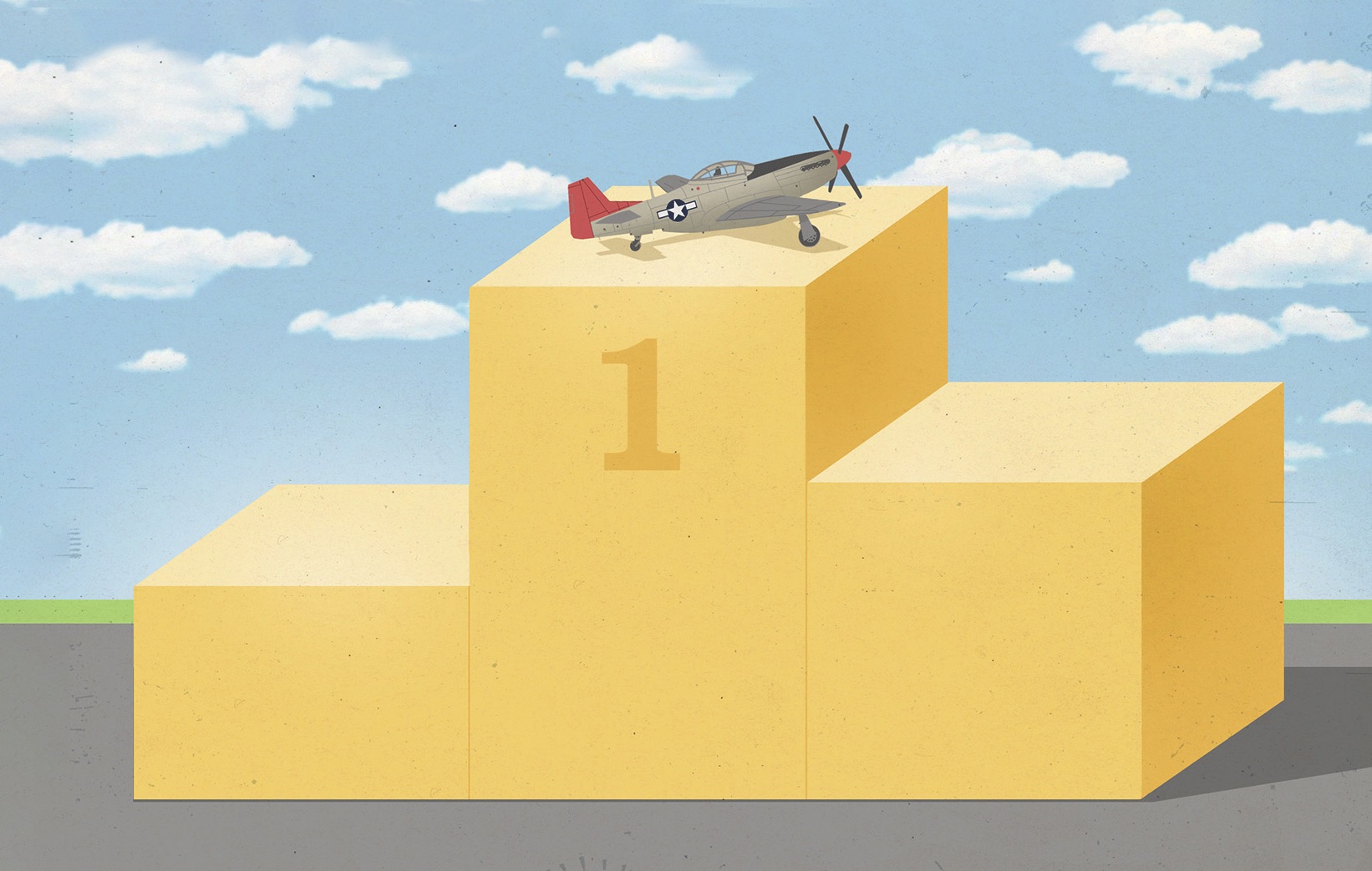With extra fuel tanks in the fuselage and two disposable auxiliary drop tanks under each wing, a Mustang could fly 1,650 miles without refueling. And that, reflects columnist James Holland, was a game-changer.
I’m going to offer a bold suggestion—not for the greatest, but for the most decisive aircraft ever built, and by that I mean the aircraft that has had the most impact. For me, it’s the P-51 Mustang.
I’d reached this conclusion some time ago, but a few weeks back I had the chance to go up in a converted two-seater P-51D. There’s an adage about aircraft that if it looks right, it probably is right, and the Mustang certainly looks the part: sleek but brawny, not the obvious beauty that is the Spitfire, but sturdier and infinitely more refined than a Thunderbolt or a Hurricane, fighters all. It also seems a generation ahead of early-war fighters in development. As I have learned, it certainly was so in construction, which made it quicker and cheaper to build—a massive advantage in a time of total war.
In the air, it was wonderful: effortlessly agile, fast, and rock-solid. For a golden minute, I had the controls and it barely batted an eye despite my ham-fistedness. What a treat.
Originally commissioned by the British from North American Aviation in May 1940, the Mustang did not, however, initially live up to its aesthetic promise. Not until October 1942, when Ron Harker, chief test pilot for Rolls-Royce, suggested trying it with a Merlin engine instead of the Allison it was equipped with, was its future assured. Any successful aircraft is always a marriage of powerplant and airframe, and it was the Merlin that transformed the P-51. At 10,000 feet, the P-51 could fly at 400 mph; 430 mph at 20,000; and, at 35,000 feet, a stunning 455 mph—70 mph faster than a German Me 109 or a Fw 190 at that altitude. It could dive faster than anything else and had a quicker roll rate, too.
But impressive as that was, what really made the difference was its efficient use of fuel and its ability to carry lots of it. With extra fuel tanks in the fuselage and two disposable auxiliary drop tanks under each wing, a Mustang could fly 1,650 miles without refueling. That was a round trip from England to beyond Berlin. And that was a game changer.
Why? Because the only way the Allies could successfully invade Normandy on D-Day was if they controlled the skies over much of northwest Europe—essential for attacking German supply lines to the front. To do that, they first needed to push back the Luftwaffe and hammer factories and training schools deep in the Reich. And the only way that could be achieved was if U.S. bomber forces had a fighter escort all the way there and back. Only the long-range P-51 could provide that vital protection and destroy enemy fighters at the same time.
All through the second half of 1943, the race was on to produce enough Mustangs to make the all-important difference. Otherwise, the Luftwaffe was not going to be defeated. Low-level bombing operations on German supply lines in France and northwest Europe would not be sufficient while the Luftwaffe held the skies. The fate of D-Day hung on whether this air supremacy could be achieved.
Mustangs first flew with the U.S. 354th Fighter Group, based in England, in December 1943. Gradually, then rapidly, their production ramped up. By the end of May 1944—with D-Day set for the following week—the nearest Luftwaffe airfield was 500 miles from the invasion beaches, and all bridges across the River Seine had been destroyed, railway marshalling yards hammered, Luftwaffe factories pounded, and the skies were clear. The P-51’s impact on these operations was immense. As we all know, D-Day was a success; Normandy, then France, was liberated; and then, too, all of Western Europe.
After my flight, my 13-year-old daughter went up for a spin—lucky girl—and, watching her hurtle over the airfield then climb into a victory roll, I marveled anew at this stunning little aircraft. Racking my brain, I still couldn’t think of a single aircraft that has had a greater impact than the P-51 Mustang. The most decisive aircraft. Ever. ✯
This article was published in the August 2021 issue of World War II.





